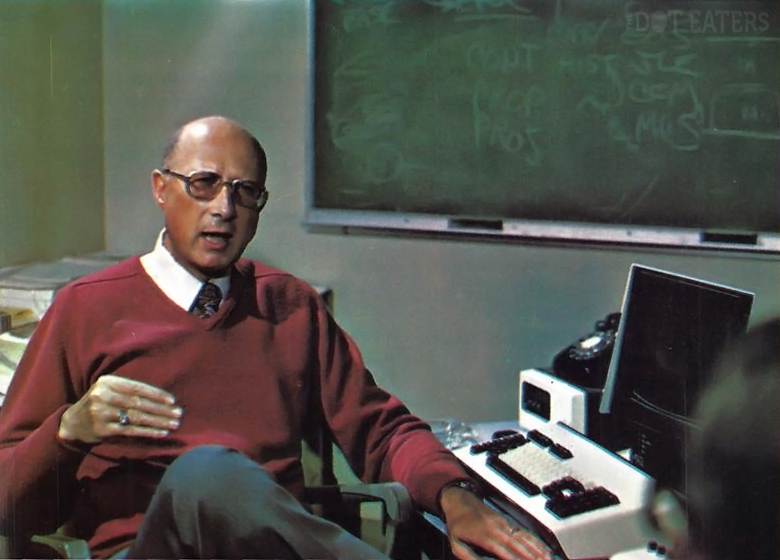GREETINGS PROFESSOR FALKEN
At 8:50 am on November 9, 1979, the warning system at NORAD Command Post, part of a huge complex hollowed out of the 9000-foot-tall, solid granite Cheyenne Mountain in Colorado Springs, Colorado lights up like a Christmas tree. Signals that indicate a large-scale nuclear attack from Soviet Russia begin to fill screens and are relayed to duty commanders at Strategic Air Command and the Pentagon. Looking over the data, military personnel consider the sub-based attack profile highly plausible. Over the next six minutes the American military complex goes into high alert: Air Force Interceptors are scrambled to protect the U.S. from Soviet bombers, ICBM missiles are warmed up in their silos, and FAA air traffic controllers enact SCATANA (Security Control of Air Traffic and Navigation Aids) operations which clear the airspace of civilian traffic in some areas of the U.S.. Even the President’s National Emergency Airborne Command Post (Doomsday plane) takes aloft, although without the President actually aboard. For these six minutes, the fate of the world hangs in the balance, until NORAD is eventually able to confirm through radar via BMEWS (Ballistic Missile Early Warning System) that no actual missiles are being detected, along with satellite data confirmation. After the alert is canceled, it is eventually determined that a technician at NORAD had loaded a war game training tape into Wimex, the computer network keeping an eye out for enemy attacks, but had failed to take the proper precautions to prevent this training data from being issued to the warning system as an actual missile launch. An off-site testing facility is constructed for future war games testing.
Hacking It
It is incidents like this, and numerous other human and technical mishaps involving the nuclear arsenal of the major superpowers, that sets the stage for two novice scriptwriters named Walter F. Parkes and Lawrence Lasker to write a movie script in 1979, titled The Genius. It starts as the germ of an idea from Lasker of a story about an alienated genius kid and his mentor, a dying scientist inspired by real-life astrophysicist Stephen Hawking. Discussing it with former college roommate Parkes, it turns out that he has had a similar inspiration. Combining their ideas, they find support for the project from producer Leonard Goldberg of Universal Studios, and so they continue fleshing out the story. During their research, they interview hackers at different schools around the U.S., including UCLA. There, they even visit a student at home, while he shows them how to hack into the UCLA mainframe. They also talk with computer security experts, such as Willis Ware of the RAND Corporation, a government think tank. They also tap members of the Stanford Research Group or SRI, such as long-time computer research engineer and computer crime expert Donn Parker, as well as Peter Schwartz. SRI is a non-profit scientific research institute involved in running nuclear war simulations for the government. It is Schwartz who gives a lead to the screenwriters about the military’s interest in videogames and the possible applications of them in training and combat. Atari’s conversion of Ed Rotberg’s popular Battlezone arcade game into a Bradley Fighting Vehicle trainer for the U.S. Military could have been another connection. One piece of the puzzle they do read about is the SIOP or Single Integrated Operational Plan. This is basically an ever-refined playbook of how the U.S. would deploy nuclear weapons, with various attack options offered, depending on the circumstances at play.
Slowly the script evolves into the story of an alienated hacker teen who infiltrates, originally, a space-based laser defense system. Through later revisions, this evolves into a war plans computer at NORAD, setting things in motion towards nuclear armageddon, with the dying now-computer scientist mentor overcoming his bitterness with the world to help the young man save it.
Crystal Palace
Born from the fallout of the first nuclear bomb tests conducted by the Soviets soon after WWII, as well as the launch of the Sputnik satellite in 1957, NORAD or North American Aerospace Defense Command is a joint defensive organization between the U.S. and Canada, tasked to track all man-made objects in Earth space, as well as to detect any airborne attack against North America. Drilled nearly a mile into the solid granite core of Cheyenne Mountain, Colorado Springs, Colorado, NORAD HQ can withstand an up to 30 megaton nuclear blast, within 2 kilometers of the site. With NORAD HQ playing a prominent part in their story, Lasker and Parkes touch base with the Air Force Los Angeles Public Affairs Office to set up a research trip. On September 15, 1980, this trip is facilitated by Lt. Col. Duncan Wilmore, the Air Force Public Affairs Officer in LA. The two screenwriters travel to NORAD Defence Command at Cheyenne Mountain Incognito, ostensibly as part of a VIP tour of Los Angeles civic leaders. At the end of their tour of the facility, they are apprehended by General James V. Hartinger, NORAD Commander in Chief, a rambunctious type who’s aware of their intentions and leads them off to the base bar to have a drink and discuss the script. The two writers win the heart of Hartinger by emphasizing the aspect of their story about the need for human control of the nuclear arsenal, rather than putting it under computer control, something they had received hints of happening during their research. The General enthusiastically agrees and relays to them that contractors and technical experts are indeed trying to take the decision-making process for nuclear retaliation out of human hands. “I sleep pretty well knowing I’m in charge”, he tells the two scriptwriters, a phrase that would echo through, in slightly altered form, to his eventual equivalent in the finished film. Lasker and Parkes also put their method of infiltrating NORAD via a tour group into the film, only this time as a way for Lightman to exit the facility unnoticed.



















I was extremely impressed with t he accurate detail of this article. I was the Location Manager on “War Games” for 7 months. Robert Decker. I try to read what is written on the film and there is usually quite a fewof inaccuracies.
Anyone is welcome to email me with questions.
coitdeck@yahoo.com
Thanks so much for commenting on the article! I’m glad to hear that my research has been met with approval from someone who actually worked on WarGames. My quest to get it right just might have been prompted by the fact that this is one of my favourite movies. Thanks again for reading AND commenting!
Hi there, jᥙst wanted to mention, I loved this article.
Ιt wɑѕ helpful. Keep оn posting!
Thanks for the kind words, and thanks for reading it!
Excellent article. I can recall seeing this movie in science class and I knew immediately I had to have a computer. I had no interest in one prior to seeing this movie.
Thanks for the kind words. I remember being jazzed up on the whole online thing, but at the time it was pretty hard to network with the ColecoVision except network with all the kids in the neighbourhood around the console, heh. I imagine memories of WarGames might have been in the back of my mind when I jumped through hoops to log onto fidonet through BBS’s in the 90s. WOULD YOU LIKE TO PLAY A GAME? NAMELY TRADEWARS?
To-99/4A also had a game, Computer War, based ostensibly on the movie. The games was made of two parts – an action stage to shoot down icbms, and a puzzle stage to match patterns with the computer.
Thanks for pointing that out.
The real way to get free calls from a pay phone in the 1980s and 1990s (as opposed to what Broderick does in the movie, which doesn’t work) was with a red box, which you could make out of a Radio Shack pocket tone dialer by soldering in a different crystal. https://en.wikipedia.org/wiki/Red_box_(phreaking)
You mean you can’t take a soda can pop-top and short out the pay phone chassis for free calls? Hollywood, you let me down again.
Cap’n Crunch is made by Quaker Oats, not General Mills.
Whoopsie, I choked on my cereal when I read your post. I will correct my mistake, and point out that Cap’n Crunch contains a whopping 754mg of sodium per serving, or 31% of the daily recommended intake! The Cap’n surely be a salty dog! Thanks for writing! Yaaar.
Don’t you just love idiots who point out a mistake in a massive article like this rather than at least give a compliment or two before doing so? Once again, excellent article
I have to say that I enjoy any user interaction with the site, both positive and negative. Negative, because no matter how many times I review the material there are always things to improve here and there, and it helps when people point out things I can correct and make the site that much better. And positive because, I also like hearing positive things! As always, thanks for your kind words.